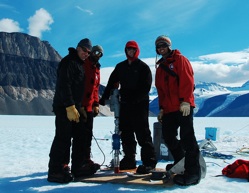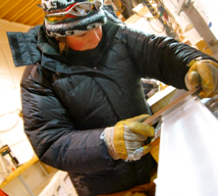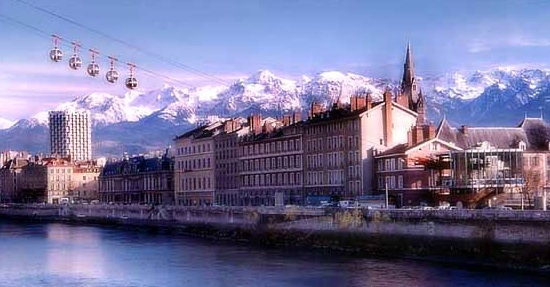ICEICS Home Page at Oregon State University

ICEICS (International Collaboration and Education in Ice Core Science) is a multi-institutional program funded by the Office of International Science and Engineering and the Office of Polar Programs at the National Science Foundation, through the Partnerships in International Research and Education (PIRE) program. Several postdoctoral, graduate, and undergraduate positions exist with opportunities for international research. Please see the Opportunities links.
Working with 12 other institutions, the aim of the project is to ultimately provide a continuous view of Earth’s climate for the past 800,000 years, based upon analysis of dust and trace gases found in ancient ice cores taken from Antarctica and Greenland. This program provides a vehicle for scientists and students to glean insight into understanding the impact of greenhouse gases on global climate at times in the distant past, how climate changes may have created greenhouse gases, and the “feedback loops” that can amplify some of these changes. Understanding the past should provide insights into how current or projected levels of greenhouse gases will affect Earth’s future climate. One of the tools the group plans to develop is the use of laser spectroscopy to replace older-generation technology such as mass spectrometry. Laser lights can detect molecules of interest more quickly and more accurately than the older instruments. Development of new computer models to analyze abrupt climate change is also anticipated.
Program Objectives
- Objective 1. Develop new methods for analyzing atmospheric methane, nitrous oxide, carbon dioxide, and carbon monoxide in ice, and the isotopic composition of water vapor.
- Objective 2. Develop a new quantitative model of the transition of snow to ice, and the transport of gases in the firn layer, integrating these processes.
- Objective 3. Improve precision of ice core deep ocean gas paleothermometer.
- Objective 4. Obtain new views of climate, gases, dust and aerosols using new analytical
and modeling tools and new ice core samples, including integration of objectives 1-3.
PIs and Senior Personnel, Institution, and Areas of Research
- Lead PI Edward Brook, Professor, Department of Geosciences, Oregon State University, Ice core trace gas records, cosmogenic isotopes, extraterrestrial dust.
- Co-PI Mary Albert, Thayer School of Engineering, Dartmouth College, Snow physics, transport phenomena, firn processes and structure.
- Co-PI Joe McConnell, Desert Research Institute, Nevada System of Higher Education, Snow and global-scale hydrology, ice core and atmospheric chemistry, glaciology, and ice sheet mass balance.
- Co-PI Jeff Severinghaus, Scripps Institution of Oceanography, UC, San Diego, Noble Gases, nitrogen, and oxygen in ice core records, ice core paleoclimate, ice core and global temperature reconstructions.
- Co-PI Todd Sowers, Earth and Environmental Systems Institute, Penn State University, History of global biogeochemical cycles involving trace gas species, microbiology of biota living in ice sheets.
- Co-PI Ed Waddington, Department of Earth and Space Sciences, University of Washington, Glacier and ice sheet dynamics, paleoclimates.
- Co-PI Jim White, Institute for Arctic and Alpine Research, University of Colorado, Global change, paleoclimate dynamics, biogeochemistry, Stable Isotopes.
- Co-PI Gisela Winckler, Lamont Doherty Earth Observatory, Columbia University, Geochemical tracers of dust in ice core records, noble gas geochemistry.
International
- Jerome Chappellaz, Director of Climate Team, Laboratoire de Glaciologie et Géophysique de l'Environnement (LGGE), University of Grenoble, France, Climate dynamics, greenhouse and other gases in ice cores, biogeochemical cycles, chronology.
- Valérie Masson-Delmotte, Laboratoire des Sciences du Climat et l'Environnement (LSCE), Paris, France, Climate and water cycle changes using stable isotope measurements.
- Dorthe Dahl Jensen (Director) and Thomas Blunier, Center for Ice and Climate, Niels Bohr Institute, University of Copenhagen, DAHL-JENSEN: Reconstruction of climate records from ice cores and borehole data, Ice flow models to date ice cores. BLUNIER: Trace gases in ice cores, ice core chronology.
- Kenjii Kawamura, National Institute of Polar Research, Japan, Climate dynamics from ice core records, noble gases in ice cores.
- Thomas Stocker (Director) and Hubertus Fischer, Department of Climate and Environmental Physics, University of Bern, Switzerland. STOCKER: Dynamics of the Climate System, climate modelling, past and future climate change, abrupt climate change, ice core analysis, isotopes in the environment, radiocarbon. FISCHER: Ice core studies on aerosols, greenhouse gases and stable water isotopes quaternary changes in climate and the atmosphere, past changes in global biogeochemical cycles, development of new high-precision mass spectrometric techniques.
Advisory Board
- Marty Fisk, Oregon State University College of Oceanic and Atmospheric Sciences and Interim Dean of the Graduate School.
- Thorsten Keifer, Executive Director of Past Global Changes (PAGES).
- Andy Nyblade, Department of Geosciences, Penn State University.
- Ross Virginia, Environmental Studies, Dartmouth College.
- Eric Wolff, Science Leader for Chemistry and Past Climate, British Antarctic Survey.
.




